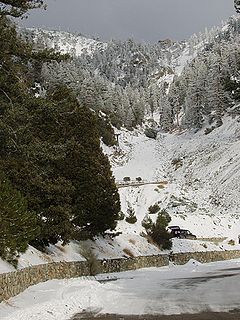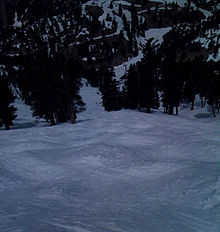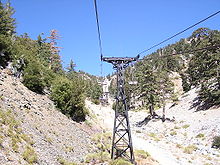- Mount Baldy Ski Lifts
-
Mt Baldy Ski Lifts
Ski lift from parking area on a snowy dayLocation Mount San Antonio and Telegraph Peak Nearest city San Antonio Heights, California Coordinates 34°16′12″N 117°37′18″W / 34.27°N 117.6216°WCoordinates: 34°16′12″N 117°37′18″W / 34.27°N 117.6216°W Vertical 2,100 ft (640 m) Top elevation 8,600 ft (2,600 m) Base elevation 6,500 ft (2,000 m) Skiable area 800 acres (320 ha) Runs 26 total
 15% beginner
15% beginner
 31% intermediate
31% intermediate
 54% advanced
54% advancedLongest run 2.5 mi (4.0 km) Lift system 4 Snowfall 170 in (430 cm) Night skiing None Web site www.mtbaldy.com Mt Baldy Ski Lifts, or "Baldy" for short, is a family owned and operated ski resort located in San Bernardino County, California, on Mount San Antonio (AKA Mt Baldy). The resort is run by the Ellingson family. The ski resort features traditional runs, open bowls, chutes, and tree runs; and claims to be "The largest and steepest resort in Southern California," with 26 runs spanning 3 mountains featuring a peak elevation of 8,600 ft (2,600 m). Baldy spans 800 acres (320 ha) with a 2,100 ft (640 m) vertical drop, and is located just 45 mi (72 km) from Los Angeles, making it the closest resort to the city.
Contents
Background
The vintage ski lifts were installed half a century ago by Harwood Developments. They were operated as Mt Baldy Ski Lifts Inc, and managed by Herbert Leffler from 1953 until his retirement in 1969. An investment group under the leadership of Charles Lewsader purchased the resort in 1969.
The ski area is multi-directional, with portions of the main ski area facing south or southwest and other portions north-facing. Thunder Mountain areas serviced by Chair 3 are north-facing, resulting in longer-lasting snow conditions. The majority of the steep Chair 1 terrain down to the base area and parking lot along with the Chair 4 portion of the resort faces west and south, resulting in frequent spring conditions and corn snow. Snow on the lower portion of the mountain is typically hard with afternoon softening on north-facing slopes due to brief thaw/shade conditions. In times of abundant snowfall, prior to complete solar melting of the snowpack on south-facing slopes, there is sun-drenched skiing on the slopes from Chair 4 down to the base area. The annual snowfall of Mt Baldy is highly variable, as is the case across the southern California mountains. In some seasons there is insufficient natural snow to operate the ski area for more than a few days (if at all). In other seasons, (particularly certain El Niño years), several feet of snow can accumulate and provide for good daily operation of the ski area and widespread off-piste skiing.[1]
Extreme avalanche danger, though otherwise rare in Southern California's benign climate, can exist on the steep slopes near the lower chairlift for brief periods during and just after heavy storms. These factors, combined with inadequate snowmaking resources, often make it difficult for the resort to develop a good base on which to build up enough snow for normal operation. As a consequence the resort operates sporadically in the beginning of the season, sometimes having only one run open.
After Christmas, Baldy tends to get hit with enough snow to provide full coverage of the mountain, and base depths can approach 5 to 9 ft (1.5 to 2.7 m) on big snowfall years. When Baldy has good coverage it often compares well with better known ski resorts in the Sierra Nevada, and the steep Alpine terrain provides a locally unique, "big mountain" experience. Because so many people divert to other mountains with faster lifts and more groomed runs, Mount Baldy is typically dominated by experienced snowriders who enjoy the steep and technical challenges available there.
The Baldy Volunteer Ski Patrol (National Ski Patrol member) has received awards from the national and Far West Region as the "Outstanding Small Patrol" making them the 'best in the west'.
Lifts
Chairs #1 and #3 were built in 1952 by Ringer Chairlifts and featured double swiveling chairs which allowed riders just to stand up when unloading.[2] The chairs would automatically move out of the way. The design was not without its flaws and did not take in account people's instincts to move away from the unloading area as soon as possible. Ringer Chairlifts went out of business just two years later.
In 1975 Swiss company GMD Mueller was contracted to upgrade the existing lifts reusing the old towers and to build chairs #2 and #4.
References
- ^ "Analysis of Southern California Snow Conditions". BestSnow. 2004. Archived from the original on 19 January 2007. http://web.archive.org/web/20070119175501/http://webpages.charter.net/tcrocker818/scalexpl.htm. Retrieved 16 January 2011.
- ^ "Ringer Chairlifts". Skilifts. 2004. http://skilifts.org/chairlift_manufacturers_ringer.htm. Retrieved 16 January 2011.
External links
Alpine Meadows | Alta Sierra Ski Resort | Badger Pass | Bear Mountain | Bear Valley | Boreal Mountain Resort | Buckhorn Ski Club | China Peak | Dodge Ridge Ski Area | Donner Ski Ranch | Granlibakken | Heavenly Mountain Resort | Homewood Mountain Resort | June Mountain Ski Area | Kirkwood Mountain Resort | Mammoth Mountain Ski Area | Mount Baldy Ski Lifts | Mount Shasta Ski Park | Mount Waterman | Mountain High | Northstar at Tahoe | Sierra-at-Tahoe | Snow Summit | Snow Valley Mountain Resort | Squaw Valley Ski Resort | Sugar Bowl Ski Resort | Tahoe Donner Downhill Cross country areas Badger Pass | Bear Valley | Dodge Ridge Ski Area | Northstar at Tahoe | Rim Nordic Ski Area | Royal Gorge Cross Country Ski Resort | Tamarack Resort and Lodge
Defunct Ski Areas Kratka Ridge (Snowcrest)
Categories:- Ski areas and resorts in California
- Sports venues in San Bernardino County, California
- San Gabriel Mountains
Wikimedia Foundation. 2010.



